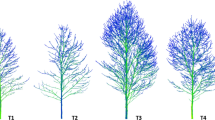Abstract
Software modules have been developed to predict the radiative environment of plant stands consisting of computer 'mock-ups' of plants. The architecture of plants used for the computation of radiative characteristics was described at the level of individual organs and simulated according to botanical rules. Three-dimensional stochastic numeric mock-ups were computed for coconut (Cocos nucifera L.) and for cacao (Theobroma cacao L.) according to the 'AMAP' methodology. Then the numerical radiative models were applied to these 'virtual plants' to describe the radiative budgets of individual plant parts and entire plants. Modelled light transmission through virtual coconut canopies was in good agreement with field measurements for different treatments and management practices including palm ages, varieties, and planting densities. In a second stage, combining the computer models of coconuts and cacao in a multistrata system, the fraction of radiation that was transmitted through the coconut canopy and intercepted by cacao was sucessfully simulated.
Similar content being viewed by others
Author information
Authors and Affiliations
Rights and permissions
About this article
Cite this article
Mialet-Serra, I., Dauzat, J. & Auclair, D. Using plant architectural models for estimation of radiation transfer in a coconut-based agroforestry system. Agroforestry Systems 53, 141–149 (2001). https://doi.org/10.1023/A:1013320419289
Issue Date:
DOI: https://doi.org/10.1023/A:1013320419289




